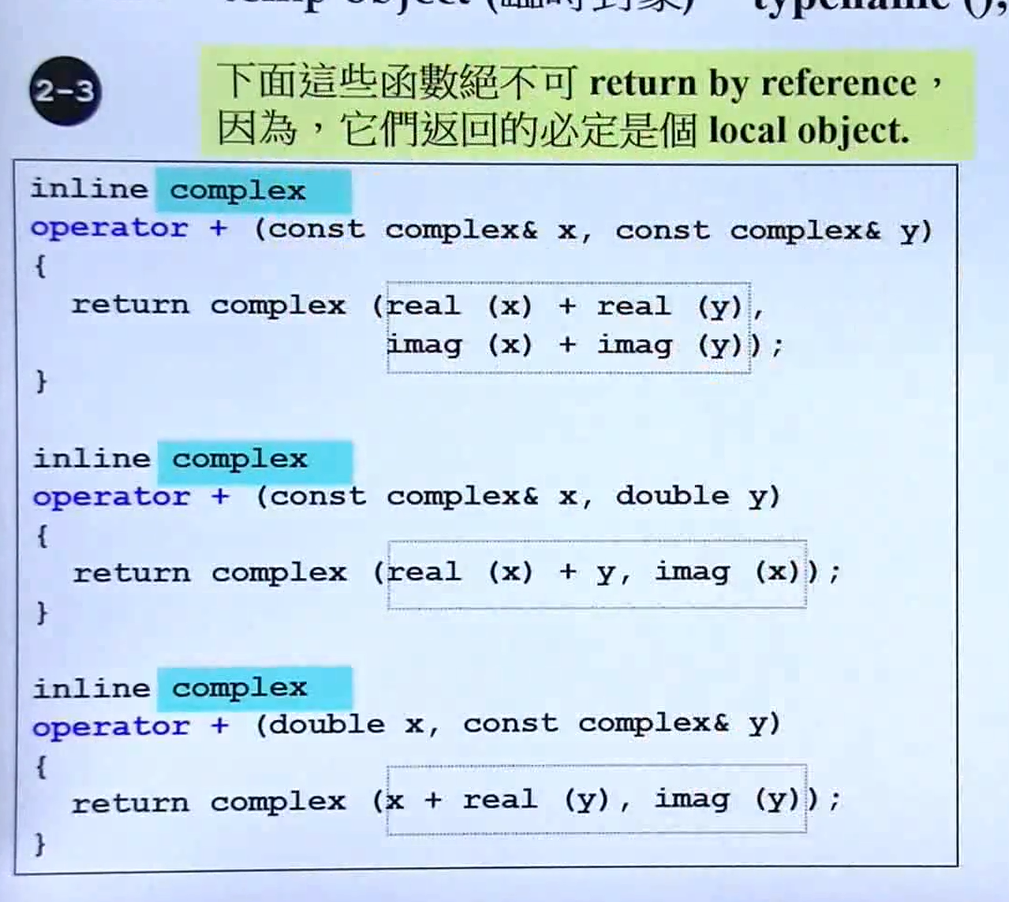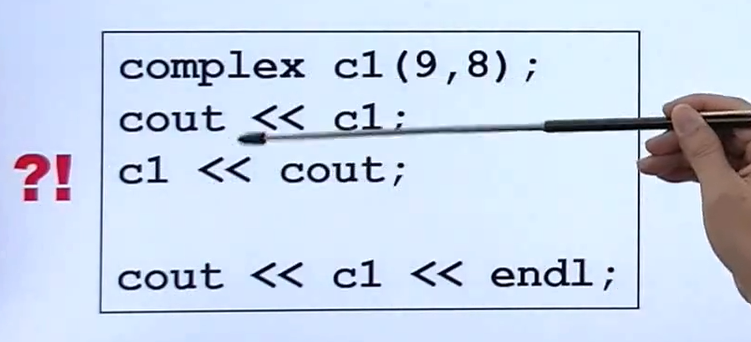侯捷《C++面向对象开发》——动手实现自己的复数类
前言
最近在看侯捷的一套课程《C++面向对象开发》,刚看完第一节introduction之后就被疯狂圈粉。感觉侯捷所提及所重视的部分也正是我一知半解的知识盲区,我之前也写过一些C++面向对象的程序,不过正如侯捷所说,我还仅仅停留于Object-based层面,写程序时总是在想如何封装好一个类,而不是Object-oriented强调类与类之间关系的设计。
这门课程分为两部分,第一部分讲Object-based,第二部分讲Object-oriented;第一部分又分为两部分:带指针的类的封装和不带指针类的封装。
本文将以模板库中的complx复数类的部分内容为核心,在分析源代码的同时,讲解一些良好的代码风格和编程习惯,比如inline内联函数的使用、friend友元函数的使用、函数参数及返回值何时pass by value何时pass by reference等等。
部分代码
complex.h
#ifndef __COMPLEX__
#define __COMPLEX__ class complex
{
public:
complex(double r = , double i = )
: re (r), im (i)
{ }
complex& operator += (const complex&);
double real () const { return re; }
double imag () const { return im; }
private:
double re, im; friend complex& __doapl (complex*, const complex&);
}; #endif
complex.cpp
#include "complex.h"
#include <iostream> using namespace std; inline complex& __doapl(complex* ths, const complex& r)
{
ths->re += r.re;
ths->im += r.im;
return *ths;
} inline complex& complex::operator += (const complex& r)
{
return __doapl (this, r);
} inline double imag (const complex& x)
{
return x.imag ();
} inline double real (const complex& x)
{
return x.real ();
} inline complex operator + (const complex& x, const complex& y)
{
return complex (real (x) + real (y), imag (x) + imag (y));
} inline complex operator + (const complex& x, double y)
{
return complex (real (x) + y, imag (x));
} inline complex operator + (double x, const complex& y)
{
return complex (x + real (y), imag (y));
} ostream& operator << (ostream& os, const complex& x)
{
return os << ' (' << real (x) << "," << imag (x) << ')';
}
源码解析
一、complex.h
1.1 initialization list
//程序1.1
complex(double r = 0, double i = 0)
: re (r), im (i)
{ }
构造函数参数缺省,比较常规。
值得注意的是,变量的初始化尽量放在初始化列表中(initialization list)。当然,完全可以在构造函数的函数体中赋值进行初始化。不过,侯捷指出,一个对象在产生过程中分为初始化和成功产生两部分,initialization list相当于在初始化过程中对变量赋值,而在函数体中赋值则是放弃了initialization list初始化这一过程,会降低效率。对于“性能榨汁机”的C++语言来讲,重视每个细节效率的重要性是毫无疑问的。
1.2参数及返回值传递方式
//程序1.2 2
complex& operator += (const complex&);
传递参数时,如果能用引用传递那么一定不要用值传递,因为值传递的过程中变量需要copy一份样本传入函数中,当参数很多或参数类型复杂时,会导致效率变慢。
其次,如果函数不会改变参数的值,一定要加const限定,在初学时养成良好的变成习惯尤为重要。
关于函数的返回值,同样是最好按引用传递,当然,有些情况无法按引用传递,这点将在2.3讲解。
其实,参数列表中还隐藏一个this,这点将在2.2讲解。
1.3友元函数
//程序1.3
friend complex& __doapl (complex*, const complex&);
我们可以看到,在complex.h文件的末尾定义了一个友元函数,友元函数打破了类的封装,它不是类的成员函数,却可以使用点操作符来获取类的private变量。当然,非友元函数也可以通过get函数来获取,不过速度会慢一些。
二、complex.cpp
2.1 友元函数及内联函数
//程序2.1
inline complex& __doapl(complex* ths, const complex& r)
{
ths->re += r.re;
ths->im += r.im;
return *ths;
}
我们首先来分析一下这个友元函数,这里有两点值得探讨:
第一这个函数将r的实部和虚部加到ths上,r在函数体中值没用发生改变,所以使用const限定。
第二这个函数被设计成inline内联函数,我们都知道,内联函数是把代码块直接复制到函数需要调用的地方,通过省略函数调用这一过程来提高效率,那么我们为什么不将所有函数都设计成内联函数呢?其实我们的inline声明只是对编译器的一个建议,对于过于复杂的函数来讲,及时我们声明了inline,编译器也会调用执行。所以,对于一些“小巧”的函数,我们尽量设计为内联函数。
2.2 隐藏的“this”
//程序2.2
inline complex& complex::operator += (const complex& r)
{
return __doapl (this, r);
}
操作符重载作为C++的特点之一,有令别的语言羡慕之处,当然也有些难以理解。
实际上,这个函数的参数还有一个隐藏的this,这个this就是函数调用者。
2.3 不能为reference的返回值
//程序2.3
inline complex operator + (const complex& x, const complex& y)
{
return complex (real (x) + real (y), imag (x) + imag (y));
} inline complex operator + (const complex& x, double y)
{
return complex (real (x) + y, imag (x));
} inline complex operator + (double x, const complex& y)
{
return complex (x + real (y), imag (y));
}
注意,这里函数的返回值不能返回reference,这其实是使用临时对象(typename ()),在函数体内定义变量,然后把这个变量的引用传递出去,函数结束后变量本体死亡,传出去的引用既没有意义了。
2.4 非成员函数的操作符重载
//程序2.4
ostream& operator << (ostream& os, const complex& x)
{
return os << ' (' << real (x) << "," << imag (x) << ')';
}
下面讲一下为什么有的操作符重载函数定义成非成员函数?
我们知道,操作符重载只作用在左边的操作数上,试想一下,如果把“<<”定义为成员函数,那每次调用岂不是要这样c1 << cout
完整代码
以上就是我在学习过程中特别注意的地方,下面给出complex类完整代码,只不过多了几种操作运算,大体思路完全一致。
complex.h
#ifndef __MYCOMPLEX__
#define __MYCOMPLEX__ class complex;
complex&
__doapl (complex* ths, const complex& r);
complex&
__doami (complex* ths, const complex& r);
complex&
__doaml (complex* ths, const complex& r); class complex
{
public:
complex (double r = , double i = ): re (r), im (i) { }
complex& operator += (const complex&);
complex& operator -= (const complex&);
complex& operator *= (const complex&);
complex& operator /= (const complex&);
double real () const { return re; }
double imag () const { return im; }
private:
double re, im; friend complex& __doapl (complex *, const complex&);
friend complex& __doami (complex *, const complex&);
friend complex& __doaml (complex *, const complex&);
}; inline complex&
__doapl (complex* ths, const complex& r)
{
ths->re += r.re;
ths->im += r.im;
return *ths;
} inline complex&
complex::operator += (const complex& r)
{
return __doapl (this, r);
} inline complex&
__doami (complex* ths, const complex& r)
{
ths->re -= r.re;
ths->im -= r.im;
return *ths;
} inline complex&
complex::operator -= (const complex& r)
{
return __doami (this, r);
} inline complex&
__doaml (complex* ths, const complex& r)
{
double f = ths->re * r.re - ths->im * r.im;
ths->im = ths->re * r.im + ths->im * r.re;
ths->re = f;
return *ths;
} inline complex&
complex::operator *= (const complex& r)
{
return __doaml (this, r);
} inline double
imag (const complex& x)
{
return x.imag ();
} inline double
real (const complex& x)
{
return x.real ();
} inline complex
operator + (const complex& x, const complex& y)
{
return complex (real (x) + real (y), imag (x) + imag (y));
} inline complex
operator + (const complex& x, double y)
{
return complex (real (x) + y, imag (x));
} inline complex
operator + (double x, const complex& y)
{
return complex (x + real (y), imag (y));
} inline complex
operator - (const complex& x, const complex& y)
{
return complex (real (x) - real (y), imag (x) - imag (y));
} inline complex
operator - (const complex& x, double y)
{
return complex (real (x) - y, imag (x));
} inline complex
operator - (double x, const complex& y)
{
return complex (x - real (y), - imag (y));
} inline complex
operator * (const complex& x, const complex& y)
{
return complex (real (x) * real (y) - imag (x) * imag (y),
real (x) * imag (y) + imag (x) * real (y));
} inline complex
operator * (const complex& x, double y)
{
return complex (real (x) * y, imag (x) * y);
} inline complex
operator * (double x, const complex& y)
{
return complex (x * real (y), x * imag (y));
} complex
operator / (const complex& x, double y)
{
return complex (real (x) / y, imag (x) / y);
} inline complex
operator + (const complex& x)
{
return x;
} inline complex
operator - (const complex& x)
{
return complex (-real (x), -imag (x));
} inline bool
operator == (const complex& x, const complex& y)
{
return real (x) == real (y) && imag (x) == imag (y);
} inline bool
operator == (const complex& x, double y)
{
return real (x) == y && imag (x) == ;
} inline bool
operator == (double x, const complex& y)
{
return x == real (y) && imag (y) == ;
} inline bool
operator != (const complex& x, const complex& y)
{
return real (x) != real (y) || imag (x) != imag (y);
} inline bool
operator != (const complex& x, double y)
{
return real (x) != y || imag (x) != ;
} inline bool
operator != (double x, const complex& y)
{
return x != real (y) || imag (y) != ;
} #include <cmath> inline complex
polar (double r, double t)
{
return complex (r * cos (t), r * sin (t));
} inline complex
conj (const complex& x)
{
return complex (real (x), -imag (x));
} inline double
norm (const complex& x)
{
return real (x) * real (x) + imag (x) * imag (x);
} ostream&
operator << (ostream& os, const complex& x)
{
return os << '(' << real (x) << ',' << imag (x) << ')';
} #endif //__MYCOMPLEX__
complex_test.cpp
#include <iostream>
#include "complex.h" using namespace std; int main()
{
complex c1(, );
complex c2(, ); cout << c1 << endl;
cout << c2 << endl; cout << c1+c2 << endl;
cout << c1-c2 << endl;
cout << c1*c2 << endl;
cout << c1 / << endl; cout << conj(c1) << endl;
cout << norm(c1) << endl;
cout << polar(,) << endl; cout << (c1 += c2) << endl; cout << (c1 == c2) << endl;
cout << (c1 != c2) << endl;
cout << +c2 << endl;
cout << -c2 << endl; cout << (c2 - ) << endl;
cout << ( + c2) << endl; return ;
}
总结
作为初学者,一定要养成良好的编程习惯,正如侯捷所说:“一出手就是大家风范”。
侯捷《C++面向对象开发》——动手实现自己的复数类的更多相关文章
- 侯捷 c++面向对象程序设计
基础知识 基于对象:Object Based 面对的是单一class的设计. 面向对象:Object Oriented 面对的是多重classes的设计,涉及到类和类之间的关系. 课程中设计到两种不同 ...
- 面向对象开发C++快速入门视频教程 C++基础加实战视频教程
课程目录: ├<C++面向对象高级开发(上)> │ ├1.C++编程简介.mp4 │ ├2.头文件与类的声明.mp4 │ ├3.构造函数.mp4 │ ├4.参数传递与返回值.mp4 │ ├ ...
- 评侯捷的<深入浅出MFC>和李久进的<MFC深入浅出>
侯捷的<深入浅出mfc>相信大家都已经很熟悉了,论坛上也有很多介绍,这里我就不多说了. 而李久进的<mfc深入浅出>,听说的人可能就少得多.原因听说是这本书当时没有怎么宣传,而 ...
- 新手如何理解JS面向对象开发?
今天有时间讲讲我对面向对象的理解跟看法,尽量用通俗的语言来表达,多多指教! 如今前端开发已经越来越火了,对于前端开发的要求也是越来越高了,在面试中,经常有面试官会问:你对JS面向对象熟悉吗? 其实,也 ...
- 侯捷STL课程及源码剖析学习2: allocator
以STL 的运用角度而言,空间配置器是最不需要介绍的东西,它总是隐藏在一切组件(更具体地说是指容器,container)的背后,默默工作默默付出. 一.分配器测试 测试代码 #include < ...
- C++标准库(体系结构与内核分析)(侯捷第二讲)
一.OOP和GP的区别(video7) OOP:面向对象编程(Object-Oriented programming) GP:泛化编程(Generic programming) 对于OOP来说,我们要 ...
- Java面向对象编程 第一章 面向对象开发方法概述
一.软件开发经历的生命周期: ①软件分析 ②软件设计 ③软件编码 ④ 软件测试 ⑤ 软件部署 ⑥软件维护 二.为了提高软件开发效率,降低软件开发成本,一个优良的软件系统应该具备以下特点: ① 可重用性 ...
- Java面向对象 第一章 面向对象开发方法概述
一.软件开发经历的生命周期: ①软件分析 ②软件设计 ③软件编码 ④ 软件测试 ⑤ 软件部署 ⑥软件维护 二.为了提高软件开发效率,降低软件开发成本,一个优良的软件系统应该具备以下特点: ① 可重用性 ...
- ASP.NET的简单与面向对象开发
ASP.NET开发,一开始是为了超赶时间完成任务,只能把功能实现即可.如下面一个功能,在网页中有一个铵钮,用户点一点切换网页的图片,再点一点又切换回来.我们要怎样做?在铵钮事件中去变更图片的路径即可. ...
随机推荐
- 用Java 8 Lambda表达式实现设计模式:命令模式
在这篇博客里,我将说明如何在使用 Java 8 Lambda表达式 的函数式编程方式 时实现 命令 设计模式 .命令模式的目标是将请求封装成一个对象,从对客户端的不同类型请求,例如队列或日志请求参数化 ...
- Nginx实践:(1) Nginx安装及日志配置
1. 安装 (1) Nginx下载地址:https://nginx.org/download/nginx-1.14.0.tar.gz (2) 安装时可能出现依赖库不存在,比如prec包,可以使用y ...
- HDU 4336——Card Collector——————【概率dp】
Card Collector Time Limit: 2000/1000 MS (Java/Others) Memory Limit: 32768/32768 K (Java/Others)To ...
- jQuery Validate使用说明
jQuery Validate 导入 js 库 <script src="./jquery-validation/lib/jquery-1.8.3.js" type=&quo ...
- 粗看ES6之函数
标签: es6 javascript 箭头函数 ES6为了书写方便引入了函数的全新简写方式-箭头函数 <!DOCTYPE html> <html> <head> & ...
- php静态变量static
静态变量 function test() { static $a = 0; echo $a; $a++; } test(); test(); test();
- POS开发问题 - 缓存问题 - 02
问题描述 : 有一个A页面使用了缓存,当从别的页面返回到A页面时, A页面绑定的有些事件,例如监听输入框输入事件:"input",监听点击触摸屏事件:"touchstar ...
- VueJs组件prop验证简单理解
今天看了vuejs的组件,看到了prop组件,主要作用是在传入数据的时候对传入的值做判断,写了个小例子. <div id="app"> <my-child :nu ...
- Android Studio 小技巧(2):AS中Button文字默认大写的问题
问题类型 设置Layout中添加一个Button <Button android:id="@+id/bt_showerror" android:layout_width=&q ...
- 在 eclipse 中调出其内置的浏览器
两种方法: 1.点击工具栏中的浏览器图标,就会在主面板中出现浏览器: 跳出一个blank页面,如下: 第二种方法:点击Window——Show view——Other 输入 "browser ...



